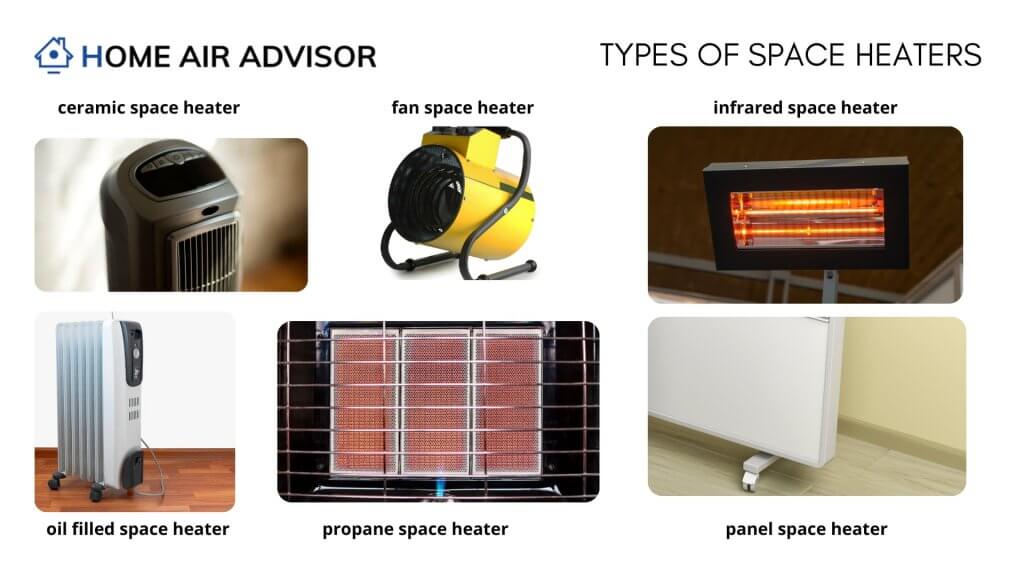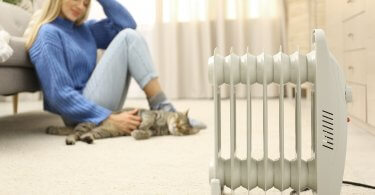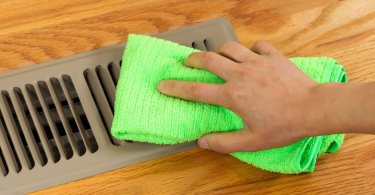Do you want some additional heating for your home? Are you considering buying a space heater but aren’t sure which to buy? This guide shows you the types of space heaters available to help you make your choice.

What Are Space Heaters?
Space heaters are devices used to heat individual rooms without increasing your home’s thermostat. They are portable and can be moved and used anywhere.
As a supplemental heating source, a space heater will have a small impact on your energy bill, but it will help reduce your home’s overall heating bill in the long run.
Different Types Of Portable Heaters
Based on how they produce heat, portable heaters are broadly classified into three types: convection heaters, radiant heaters, and heaters that are a combination of those two.
1. Convection Heaters
Convection heaters are the most efficient for heating large spaces and are easy to maintain and clean. They are oil-filled and radiate heat from an external surface area.
Convection heaters are uniquely designed to warm a room’s air and not the people. Most have a fan that distributes hot air for optimal air circulation in the room. Thus, they are also known as fan heaters, as the airflow plays an essential part in the healing process.
Convection heaters are ideal when you need to quickly heat a room with minimal noise. They are, however, not safe around children or pets as their surfaces get hot to the touch.
2. Radiant Heaters
Radiant heaters use infrared rays to warm objects and people in the room, they don’t necessarily heat the air. Thus, they are ideal for spot heating and quick heating of parts of a room or warm the people sitting in front of it.
They are silent and energy-efficient, heating 1,000 square feet compared to the 400 square feet a typical convection heater heats.
However, they come with some disadvantages.
A radiant heater emits an orange light and thus isn’t very suitable for a bedroom. There is also the risk of triggering a fire if it’s placed too close to flammable or combustible materials.
3. Combination Heaters
These heaters provide the best convection and radiant heaters and are perfect to use in any room. Though a combination heater has a fan to distribute heat, it is not as efficient as the other types of heaters.
What Are The Different Types Of Space Heaters?
Based on the three main types of portable heaters, space heaters are further divided into these six variants.
1. Ceramic Space Heaters
Ceramic space heaters run on electricity and get their name from their ceramic plates attached to the metal coils. They heat up as electricity passes through the coils. As the plates continue absorbing electrical heat, they eventually release the heat into the air.
Depending on the design, there are two types of ceramic space heaters- those with and without a fan.
Heaters with fans are called convection ceramic heaters. They blow air over the heated ceramic plates to quickly distribute air into the room.
Radiant models use electricity to warm a ceramic plate, which in turn radiates heat through the room. The heating process is longer because of the absence of a fan.
Pros
- Instantly warms up small areas.
- Provides instant heat.
- Very efficient.
- Compact, lightweight, and easy to move around.
- Heat radiates evenly after turning off because the ceramic plates take time to cool down.
- Safe for seniors and children with its excellent cold-to-touch surface.
Cons
- Not suitable for heating large spaces.
- Heaters without fans take long to heat a room.
- Physical objects may obstruct heat transfer.
- Most run and use electricity constantly to produce heat.
- Noisy.
2. Fan Space Heaters
Fan space heaters heat metal coils that transfer heat into the air. They have fans that blow all over the metal coil to push heat into the room.
Pros
- Produces instant heat that can be oscillated.
- Cheap.
- Compact, lightweight, and easy to move around.
- Cool-to-the-touch heating.
- Perfect for apartment renters and heating bathrooms.
- Most have turn-dial thermostats to pick a precise degree of heat.
Cons
- Physical objects can block heat transfer.
- Runs and uses electricity constantly to produce heat.
- Heat transfer stops once switched off.
- Not ideal for heating significantly larger areas.
3. Infrared Space Heater
Infrared space heaters run on electricity. They emit electromagnetic waves which do not heat the air but heat surrounding objects and human bodies.
As electromagnetic waves heat the area, these heaters do not need a fan. However, some units with fans help quicken the heating process.
Pros
- Ideal for heating large basements.
- Resembles real fireplaces.
- Objects do not block but absorb heat.
- Some have a digital thermostat.
- Long-lasting heat that continues even after switching off.
- Some units resemble furniture with their wood cabinet designs.
- Models with wheels or a handle are portable.
Cons
- Releases undirectional heat.
- Heavy.
- As it requires physical objects to absorb heat, there is less heat with fewer objects or people around.
- Expensive if compared to ceramic and fan heaters.
4. Oil-Filled Space Heaters
Oil-filled space heaters are portable, they run on electricity, and contain a diathermic coil. The heated oil circulates through its columns and releases hot air.
They are also called radiator heaters because they resemble old-fashioned radiators. They do not have fans because fans cannot distribute the heat produced by the oil after heating the large exterior metal surface.
Pros
- Long-lasting heat, continues even after switching off.
- Some contain a digital thermostat.
- Ideal for heating large rooms.
- Energy-efficient because it doesn’t have to run continuously to radiate heat.
Cons
- No control over the speed of heat.
- The surface gets hot, dangerous for children and pets.
- It weighs about 16-20 lbs and is heavier than most heater types.
- Cannot oscillate heat.
5. Propane Space Heaters
Propane space heaters do not depend on electricity but on liquid propane (LP) for fuel. They are thus the most portable space heaters available as power cords do not limit them. They can even heat your home during a power outage.
They produce the fiercest heat and are about 20% cheaper to run than space heaters that depend on electricity. They emit electromagnetic waves into the air to heat nearby objects and are ideal for outdoor heating areas like patios.
Propane heaters come in two types: vented for indoor use and unvented for outdoor use. For health reasons, do not use the unvented variants indoors. They reduce the oxygen levels in the room and emit harmful gasses in closed spaces.
While the units don’t need a fan to deliver heat, some models have one to quicken the heating process.
Pros
- Ideal for outdoor heating purposes.
- It doesn’t depend on electricity for power.
- Portable without restrictions of power cords.
- Cheap to buy and operate.
- Produces the fiercest heat.
Cons
- Need to have fuel ready to use at all times.
- Poses a fire and explosion risk due to its burning fuel.
- Not all models are safe for indoor use.
- Some models emit carbon dioxide and need proper ventilation.
Related article: Propane vs Kerosene Garage Heater: Which is Better?
6. Panel Space Heaters
Relatively new in the world of heaters, are panel space heaters, a combination of models that are gaining in popularity. They are lightweight and can be wall-mounted or placed on the floor.
They use electrical power to produce 80% convection heat and radiate 20% hot air. However, they can only get rid of the cold in a room but not heat it.
As they use the room’s airflow to circulate heat, they are an advantage for allergy sufferers. There is no recirculation of dust through the room.
Pros
- Easy to use by just plugging it in.
- Can be wall-mounted or used on the floor.
- Safe with children around.
- Stylish with a modern look.
- Ideal for allergy sufferers.
Cons
- Produces less heat than other space heaters.
- It can only remove the chill in a room and not warm it up.
- Minimal controls.
- Cannot move around if mounted on the wall.
Comparisons Between Popular Types Of Space Heaters
Here are some basic comparisons between the popular space heaters to help you make your choice.
1. Ceramic Heater vs Fan Heater
Both fan and ceramic heaters work with a fan and produce lots of noise.
Ceramic Heaters
- Retain heat and releases more heat into the air.
- Are safe to use around children and pets.
- It warms up small areas instantly.
- Very efficient but noisy.
- Are not meant for heating large spaces.
Fan Heaters
- Produces instant heat.
- They are cheap, compact, and lightweight.
Related article: What’s the Difference Between Infrared and Ceramic Space Heaters?
2. Ceramic Heater vs Oil-Filled Heater
Oil Heaters Are:
- Silent in operation.
- Slow to heat up.
- Ideal for heating larger areas.
- Large and can be heavy.
- Slow in cooling down.
- Not meant for families with small children.
Ceramic Heaters Are:
- Noisy.
- Quick in heating up.
- Useful for spot heating.
- Quick in cooling down.
- Smaller in size and portable.
- Safe for children and pets.
3. Fan Heaters vs Infrared Heaters
Both are economical, provide instant heat and reduce humidity and oxygen levels.
Infrared Heaters Are:
- Not safe for children and pets.
- Not ideal for large rooms.
- Consumes only 400 to 800 watts of energy.
Fan Heaters Are:
- Ideal for heating large rooms.
- Consume lots of energy, about 2000 watts of energy.
- Cheap, lightweight, and portable.
4. Infrared Heaters vs Oil-Filled Heaters
Both are energy efficient and do not produce much noise.
Infrared Heaters Are:
- Not safe for children and pets.
- Not ideal for heating large rooms.
Oil-Filled Heaters Are:
- Perfect for heating large rooms.
- Do not produce instant heat.
- Expensive.
- Not safe for children and pets.
Related article: What’s the Difference Between Infrared and Ceramic Space Heaters?
5. Fan Heaters vs Oil-Filled Heaters
Both are ideal for heating large rooms.
Oil-Filled Room Heaters Are:
- More energy efficient as the heater remains hot for hours after being switched off.
- Not burning oxygen.
- Not effective at reducing humidity levels.
- Not noisy.
- Heavy and not so portable.
- Slow in heating up, requiring about 30 minutes for the oil to reach the desired temperature.
- Quick at losing heat and need to remain on high power to retain a high temperature.
- Expensive to maintain, with high electricity bills.
- Noisy.
- Quick in heating.
- Cheaper.
- Safer with kids around as they are not hot to touch.
Fan Heaters Are:
Related article: What is a Space Heater & How Does It Work
Types Of Space Heaters For Rooms
1. Oil-Filled Heaters Are Ideal For Heating
- Bedrooms.
- Large rooms.
- Poorly insulated basements.
2. Fan Heaters Are Ideal For Heating
- A child’s room.
- Small rooms like a small office or utility room.
- Well-insulated basements.
- An entire living room or bedroom (only with larger models).
3. Propane Heaters Are Ideal For Heating
- Outdoor areas like the patio, external garages, or workshops.
- During blackouts.
4. Infrared Portable Heaters Are Ideal For Heating
- Living rooms, small rooms, and offices.
5. Panel Space Heaters Are Ideal For
- Bathrooms, bedrooms, offices, and small rooms.
FAQ
Which Type Of Heater Is The Best?
Convection oil-filled heaters can heat large areas, but ceramic heaters are very convenient and popular.
Which Heaters Are Safe To Leave On Overnight?
It is safe to leave infrared, ceramic, and oil heaters on during the night. However, it is better to switch off electric and vented propane heaters before you go to sleep.
Which Type Of Heater Is The Cheapest To Run?
Propane space heaters produce the fiercest heat. They thus are about 20% cheaper to run than space heaters that run on electricity. But not all models are fit for indoor use, and some propane heaters leak heat and fumes.
Electric heaters are comparatively 100% efficient because there is no waste of heat. Though cheap to buy, their running costs are high.
However, considering their heating efficiency, oil-filled heaters are the cheapest to run. They may be slow to heat but stay hot longer and efficiently heat even large rooms.
Related articles:
- Best Battery Operated Heater
- How Many Watts Does a Space Heater Use?
- My Electric Heater Turns On and Off Repeatedly [Fixed]
Conclusion
There is no clear winner for the best portable heater. It all depends on your individual needs and budget. Those who love the outdoors like camping may consider propane space heaters to be the best.
Someone who wants to warm a large house will prefer using an oil-filled type. Small, compact apartment owners may prefer a ceramic space heater.
You have to select a heater based on where and how often you plan to use it and your budget. Keep safety in mind and read the safety instructions before making a choice.











Leave a Comment